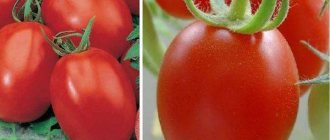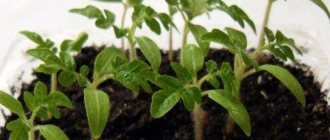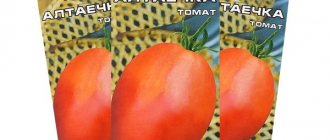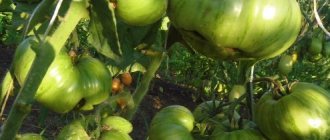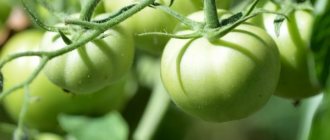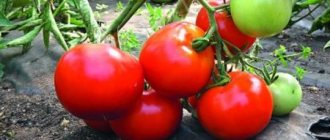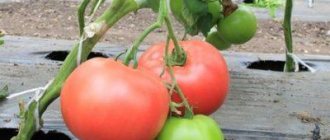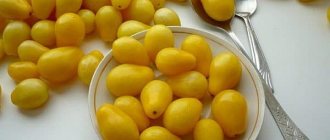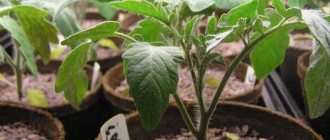Any gardener wants to show off his harvest. If we are talking about tomatoes, then the high yield of the variety, the taste of the fruit, ease of care, and immunity to diseases are valued. Unfortunately, a universal variety is not so easy to find, so sometimes you have to sacrifice, for example, yield in favor of high taste.
The Heavyweight of Siberia tomato is one of those varieties that compensate for their relatively low yields with unpretentiousness to growing conditions and excellent taste.
Description of the variety
The heavyweight of Siberia was bred by Russian breeders. Its main advantage is its unpretentiousness to the climate. It grows well both in open ground and in greenhouses.
Distinctive features
The name of the variety already indicates that the fruits of this plant are large. But the plant itself is quite compact: in a greenhouse it grows no more than 1 meter in height, and in open ground - only 70-80 cm. Distinctive features are also early maturity and high immunity.
Fruit characteristics and yield
On average, the fruit of the Heavy weighs 400-600 g, some specimens reach a weight of 1 kg. They ripen at 95-100 days. The tomatoes are heart-shaped and have dense pink flesh. The tomatoes are fleshy, sweet, with a slight sourness. Productivity 10-11 kg per 1 sq. m, or 3 kg from one bush.
In the photo there are tomatoes Heavyweight of Siberia:
Characteristics of tomato Heavyweight of Siberia
Before choosing a suitable variety, its characteristics are assessed. For gardeners, the ripening period, harvest volume, scope of application, and immunity to diseases are important.
Productivity and fruiting
According to reviews and photos, the yield of the Heavyweight of Siberia tomato is 11-12 kg/sq. m. 3-3.5 kg of fruits are obtained from the bush. The fruits ripen 70-80 days after the tomatoes germinate.
The variety is grown in open areas and under cover. Regular watering and fertilizing with complex fertilizers have a positive effect on productivity.
Area of application of fruits
The tomato has a table purpose. It is used fresh for appetizers and salads, and also processed to make soups and sauces. The variety is not suitable for whole-fruit canning. Tomatoes are used to make juices, pastes, and vegetable salads for the winter.
Resistance to diseases and pests
The variety is resistant to major viral and fungal diseases of the crop. Compliance with agricultural practices and preventive spraying helps to avoid the spread of diseases and pests.
Advantages and disadvantages of the variety
Advantages of planting tomato Heavyweight of Siberia:
- good taste and presentation;
- high transportability;
- resistance to cold weather, diseases and pests.
The main disadvantages of the variety:
- average yield;
- low drought resistance.
How to grow seedlings
Preparing seedlings of this variety does not require special skills. The procedure is not much different from the standard procedure for tomatoes.
Seed preparation
For seedlings, you can use both purchased seeds and your own. Just remember that seeds from previous harvests should be replaced every 5 years so that the variety does not lose its qualities.
Seeds are disinfected in a weak solution of manganese, and then kept for about 20 minutes in a solution of Fitosporin to speed up their germination. A solution is prepared from 1.5 g of drug powder and 100 ml of water.
Container and soil
You can plant seedlings either in wooden boxes or in plastic cups 15-20 cm high. You can buy ready-made soil, or you can prepare it yourself. To do this, mix chernozem and humus in equal proportions. You can add 1 part of peat to the same soil.
Sowing
Sowing begins in the second half of March (for subsequent planting in a greenhouse) or in April (for plants being prepared for open ground). The seeds are planted to a depth of 1 cm. A distance of about 2-3 cm is left between the holes, and from 5 to 7 cm between the rows of seeds.
The seeds are carefully sprinkled with soil, and then the container is covered with polyethylene.
Growing and care
It is important to keep the seedlings in a dark and warm place. The film must be lifted periodically to ensure air access and to remove condensation.
Sprouts appear 10-14 days from planting. They are placed in a lighted place, but care is taken to ensure that the room is warm. During the day, the temperature should not fall below 20-22 degrees, and at night - 16-18 degrees. Draft is not allowed. Provide lighting (artificial or natural) for 12-14 hours a day.
Don't forget about watering. It must be carried out every 7 days with melted or settled water. If the plants look weak, do not neglect feeding.
After the first leaves appear, the tomatoes can be transplanted into large containers (5 l). They need to be filled with the same soil as when sowing seedlings.
Climate
The description and characteristics of the tomato variety Heavyweight of Siberia indicate that it is absolutely not intended for hot climates (more than +30 degrees). Therefore, this variety cannot be found in warm regions. For seed germination, the optimal temperature is 23-25 degrees.
Therefore, what kind of harvest gardeners will reap depends on what kind of summer it will be. Moderate temperatures during the summer will bring gardeners a tasty and large-fruited harvest. Hot weather will significantly reduce tomato yields.
Those who planted such plants noticed that choosing the right place for planting will help protect themselves from sour fruits. It should be well lit and sunny. In this case, the fruits will be tasty.
There is a difference in planting time for different growing methods:
- In April, tomatoes are planted in heated greenhouses;
- In May, the time comes to plant the Heavyweight in greenhouses without a heating system;
- June is the right time to plant in open ground.
The place for planting tomatoes is chosen to be neutral, light and highly fertile soil. Sowing of seeds is carried out 60-65 days before the intended planting in the ground.
At what age is a cat castrated: the optimal time for surgery
This crop must be watered abundantly with warm water and fed with fertilizers that contain minerals. The tomato should be picked when a couple of leaves appear. The plant is fed when planted in the ground, and also as soon as the first ovaries appear.
Stepchildren need to be removed if the goal is to get a luxurious bush and grow large fruits. But this is not mandatory. Also, in order to get large fruits, the ovaries are cropped, thereby you can get tomatoes weighing 700-800 grams.
Description of the variety Heavyweight of Siberia has a strict planting scheme: 3-5 plants per 1 square meter. m. plot. If you ignore this recommendation, the yield will suffer.
Caring for tomatoes consists of:
- Timely watering of plants;
- The use of fertilizers that contain mineral fertilizers;
- Prevention of plant diseases;
- Stepsynching (if necessary);
- Removing weeds.
In subsequent years, it becomes possible to grow this crop from your own seeds. This guarantees a great tasting harvest.
How to grow tomatoes
Before planting in the ground, harden the seedlings: 20 days before, periodically open the window or transfer the tomatoes to the balcony.
Landing
You can transfer seedlings to open ground or a greenhouse as early as 50-60 days. If you grow tomatoes in open ground, be sure to wait for consistently warm weather without frost.
Before planting, make sure the soil is disinfected. The soil is dug up and fertilized with compost. A good solution would be to plant tomatoes in the same soil where cucumbers, cabbage, garlic, and onions grew last year.
Plant bushes sparsely: no more than 4 plants per 1 square meter. m, leave a distance of 40 cm between tomatoes and 50 cm between rows. Plant to a depth of 20 cm.
Immediately after planting, water the plants with Fitosporin solution for disinfection, cover thoroughly with soil and water.
Care
Despite the fact that Heavyweight is resistant to relatively low temperatures, this variety does not tolerate drought well. Therefore, the bushes must be watered every week, providing each plant with 5 liters of water.
It is important to weed your tomatoes to prevent weeds from taking away nutrients. The soil also needs to be loosened periodically. This is a good prevention of late blight.
To fertilize before flowering, use natural fertilizer - manure. When the bushes begin to bear fruit, they switch to superphosphate and potassium sulfate. To prepare, dilute 40 g of one of these substances in 10 liters of water. Wood ash is also suitable for feeding.
Features of cultivation and possible difficulties
Despite the fact that the bushes of the Heavy of Siberia are small (therefore they do not require pinching), they need to be tied up: large fruits can break weak branches. That is why it is recommended to tie up not only the stem itself, but also each large tomato. This is done using the so-called slingshot.
The heavyweight of Siberia does not tolerate high temperatures well. Therefore, try to maintain the air temperature in the greenhouse no higher than 30 degrees.
Diseases and pests
Like most tomatoes, Heavyweight is susceptible to late blight. The variety can also suffer from root rot and tobacco mosaic.
It is better to prevent diseases than to fight them, so do not forget to regularly ventilate the greenhouse, loosen the soil, and also periodically use both chemical and natural preparations that can overcome these diseases.
Further care
After transplanting the seedlings of this tomato to a permanent place, you need to care for them as follows:
- Water as the soil dries, avoiding stagnation of moisture in the soil. You also need to make sure that drops of moisture do not fall on the foliage of the bushes;
- application of mineral and organic fertilizers during the entire period of growing tomatoes with an interval of 12-14 days;
- mandatory regular removal of weeds from tomato beds;
- if necessary, stepchildren should be removed and bushes should be formed with no more than 3 stems;
- reduce the number of ovaries to increase the size of the fruit;
- preventive measures to prevent diseases and pest attacks.
Related article:
How to preserve fresh tomatoes for a long time
Harvesting and application
Tomatoes are harvested 95-100 days after planting in the ground. Ripe fruits can be eaten either fresh or prepared into juices, pastes, stews, etc. Not suitable for pickling, as the fruits are too large.
Note! The variety can be consumed by people with gastrointestinal problems, since this tomato contains few acids.
Advantages and disadvantages of the variety
Like any variety, Heavyweight of Siberia has a number of advantages and disadvantages.
The advantages include:
- resistance to adverse weather and climatic conditions;
- easy plant care;
- beautiful appearance, large fruits and high taste;
- the possibility of using seeds for cultivation in the future.
But there are also some disadvantages:
- relatively low yield;
- the need to tie up not only plants, but also fruits.
Farmer reviews
Ella, Novokuznetsk, 32 years old: “I raised a Siberian heavyweight in a greenhouse. The bush was very tall, almost reaching the roof. I rarely took care of my stepson, and I didn’t particularly care for her, since I come to the dacha once a week. The tomatoes were quite large, about 350-450 g each. I really liked the taste. I will definitely plant again.”
Marina, Kamen-on-Obi, 48 years old: “I really liked growing this variety. Unpretentious, does not require much attention and care, but at the same time produces very large fruits. I almost didn’t take stepson. I just placed boards under the brushes. I planted 12 bushes, but not a single tomato cracked. All were straight and intact. Very sweet and tasty."
Ekaterina, s. Maryanovka, 51 years old: “I’ve been imprisoning a heavyweight for six years in a row. Your own seeds. Excellent variety. Suitable for those who cannot or do not want to constantly tinker in the garden. I fertilized it only twice with mullein, there were a lot of tomatoes. I grow it mainly for salads. I don’t use it for preparations – there isn’t enough, we eat it all.”
